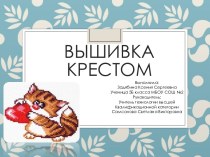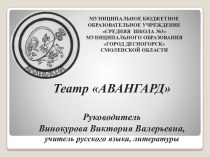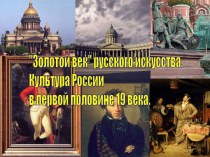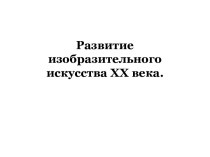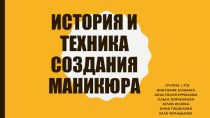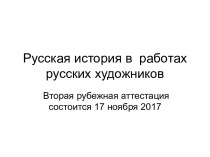- Главная
- Разное
- Бизнес и предпринимательство
- Образование
- Развлечения
- Государство
- Спорт
- Графика
- Культурология
- Еда и кулинария
- Лингвистика
- Религиоведение
- Черчение
- Физкультура
- ИЗО
- Психология
- Социология
- Английский язык
- Астрономия
- Алгебра
- Биология
- География
- Геометрия
- Детские презентации
- Информатика
- История
- Литература
- Маркетинг
- Математика
- Медицина
- Менеджмент
- Музыка
- МХК
- Немецкий язык
- ОБЖ
- Обществознание
- Окружающий мир
- Педагогика
- Русский язык
- Технология
- Физика
- Философия
- Химия
- Шаблоны, картинки для презентаций
- Экология
- Экономика
- Юриспруденция
Что такое findslide.org?
FindSlide.org - это сайт презентаций, докладов, шаблонов в формате PowerPoint.
Обратная связь
Email: Нажмите что бы посмотреть
Презентация на тему General notes on style and style study (lecture 1)
Содержание
- 2. 1.1. The Concept of StyleThe term "style"
- 3. Galperin: “Style is a system of interrelated language means which serves a definite aim in communication.”
- 4. Y. M. Skrebnev: “Style is a specificity
- 5. Seymour Chatman:"Style is a product of individual choices and patterns of choices among linguistic possibilities."
- 6. The term “style” applies to the following
- 7. Style is the correspondence between thought and expression.
- 8. The linguistic form of the idea expressed
- 9. Style is embellishment of language.
- 10. Style is a technique of expression.
- 11. Style signifies a literary genre.
- 12. A style of language is a
- 13. I. Arnold mentions four styles: poetic style, scientific style, newspaper style, colloquial style.
- 14. I.R. Galperin distinguishes five major functional styles
- 15. We distinguish six styles within the English
- 16. 1.2. Style Study and its SubdivisionsStyle Study
- 17. I. Galperin defines Style Study as a
- 18. The subject matter of Style Study is
- 19. The main aims of Stylistics are:1) to
- 20. The stylistics of language analyses permanent or
- 21. Т.A. Znamenskaya: Stylistics of speech studies the
- 22. Stylistics of resources is a descriptive
- 23. Comparative stylistics analyses the stylistic resources not
- 24. Linguo-stylistics compares National Language Standard or
- 25. Language means may be studied at different
- 26. Stylistic lexicology or Lexical stylistics Lexical stylistics
- 27. Stylistic Phonetics or PhonostylisticsStylistic Phonetics is engaged
- 28. Stylistic grammar Stylistic Morphology is interested in
- 29. Stylistic grammarStylistic grammar studies syntactic, expressive means,
- 30. Literary stylistics studies the totality of expressive
- 31. Functional stylistics deals with all the subdivisions
- 32. In terms of information theory the author's
- 33. The stylistics, proceeding from the norms of
- 34. The key notions of stylistics: imagery, expressiveness, evaluation, emotiveness, expressive means,stylistic devices.
- 35. Text is understood as a product of
- 36. Stylistics focuses on the expressive properties of
- 37. Expressiveness is understood as a kind of
- 38. Emotiveness, and correspondingly the emotive elements of
- 39. Expressiveness is a broader notion than emotiveness
- 40. The evaluation is also based on whether
- 41. Stylistics is first and foremost engaged in
- 42. The linguistic units of phonetic, morphological,
- 43. Stylistic devices (tropes, figures of speech)
- 44. All stylistic devices are the result
- 45. THANK YOU FOR YOUR ATTENTION!
- 46. BIBLIOGRAPHY1. Essential Literature1. Арнольд И.В. Стилистика. Современный
- 47. Скачать презентацию
- 48. Похожие презентации


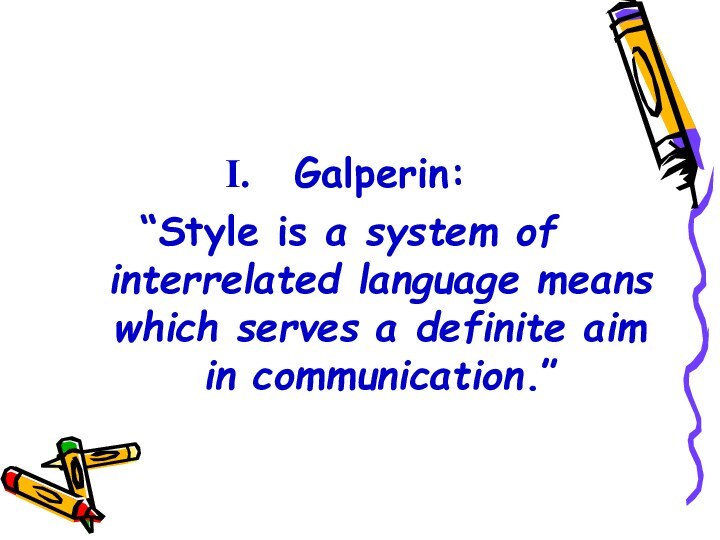
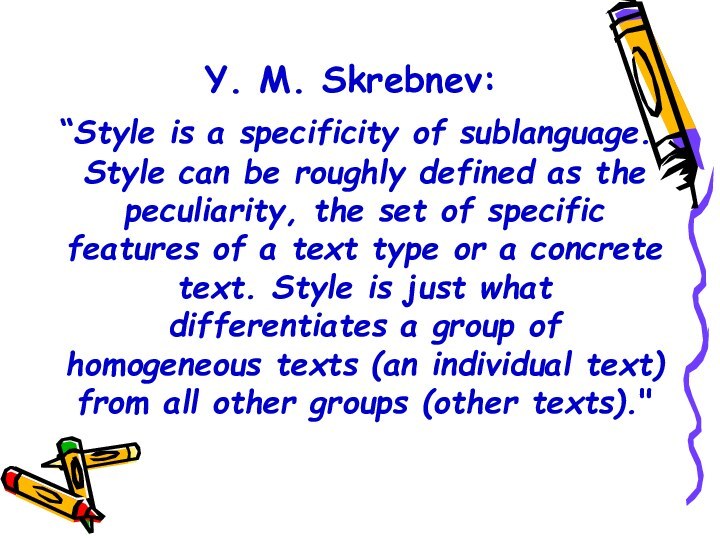

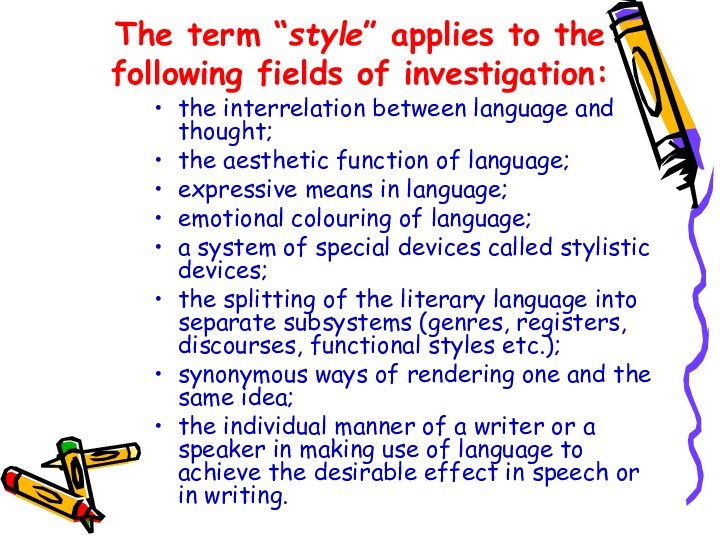
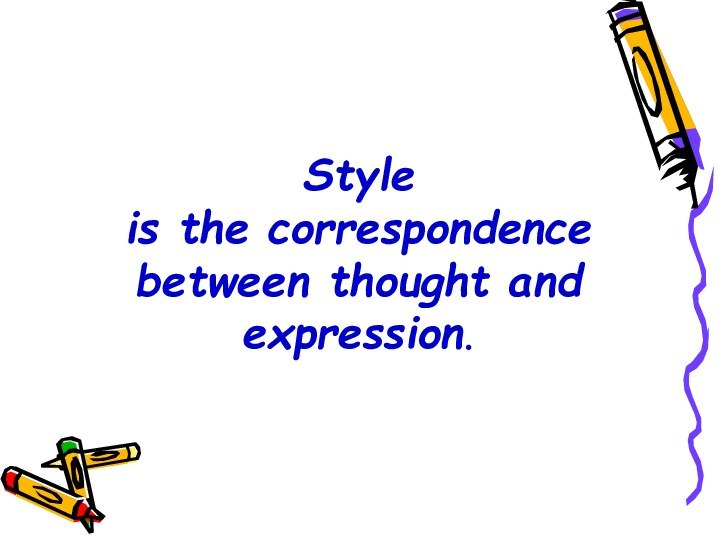
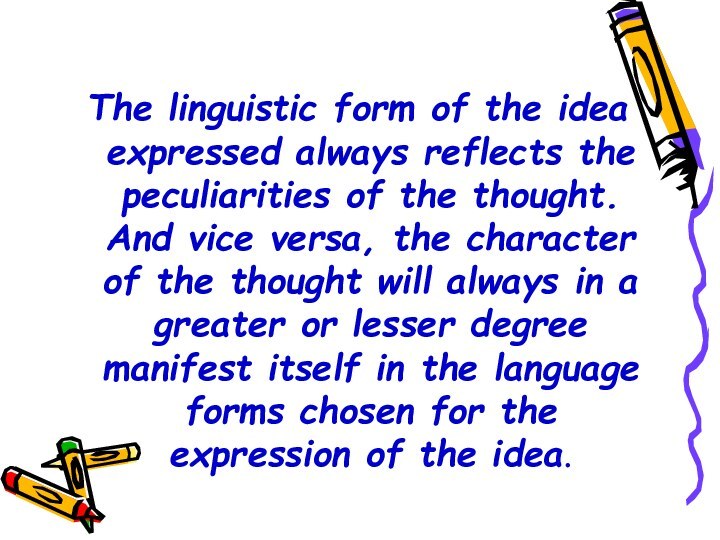

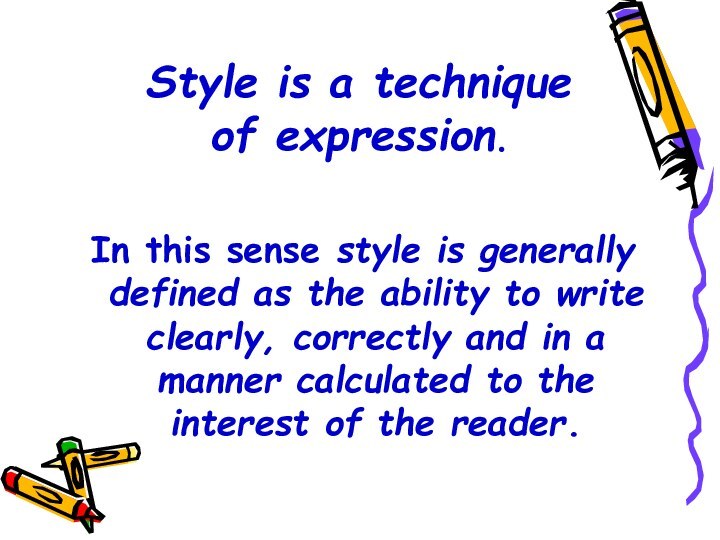
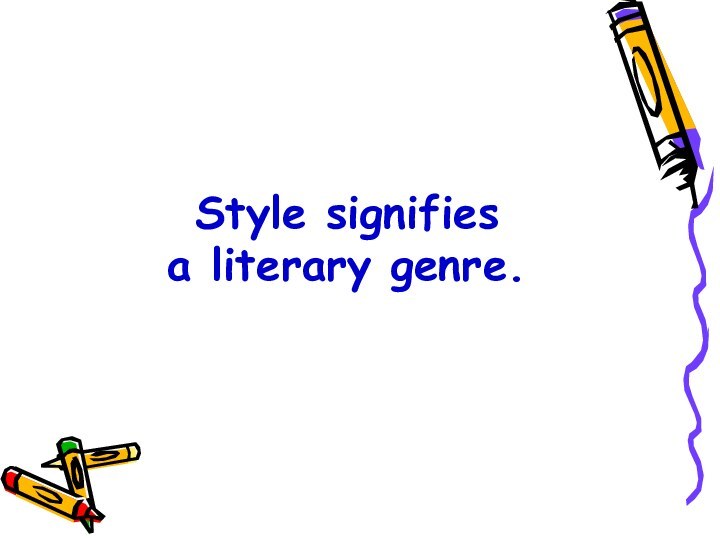

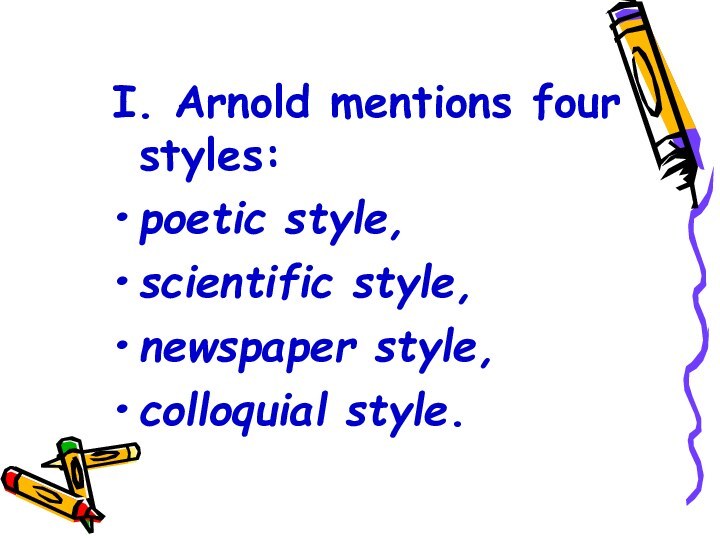
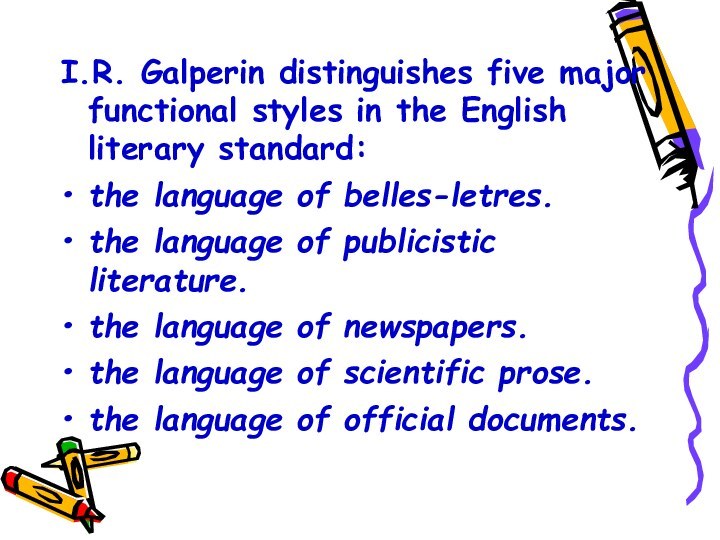




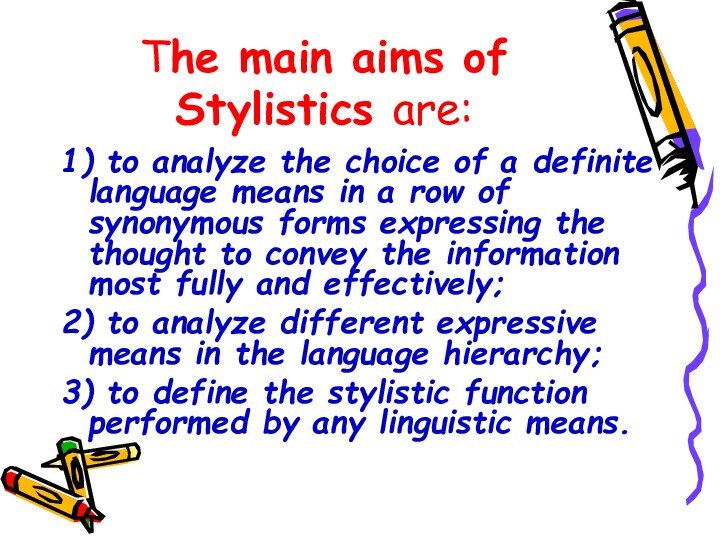

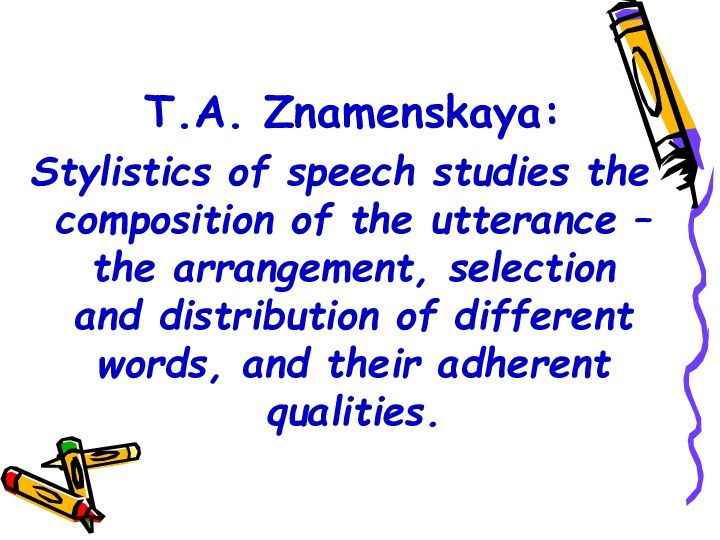
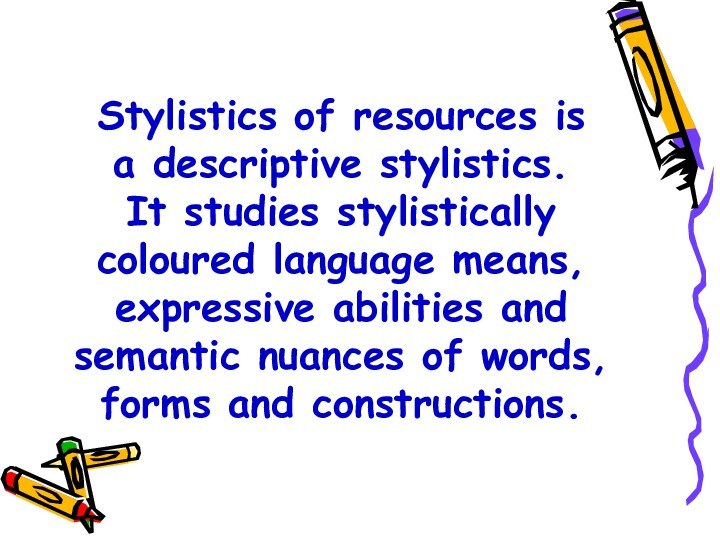

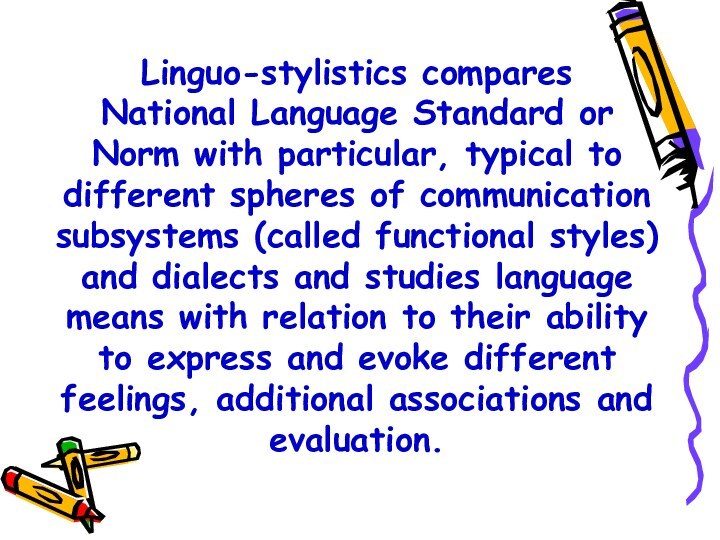

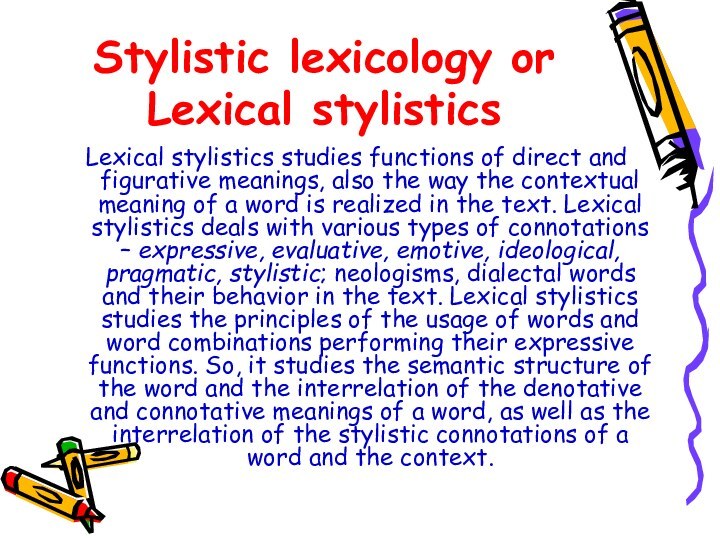
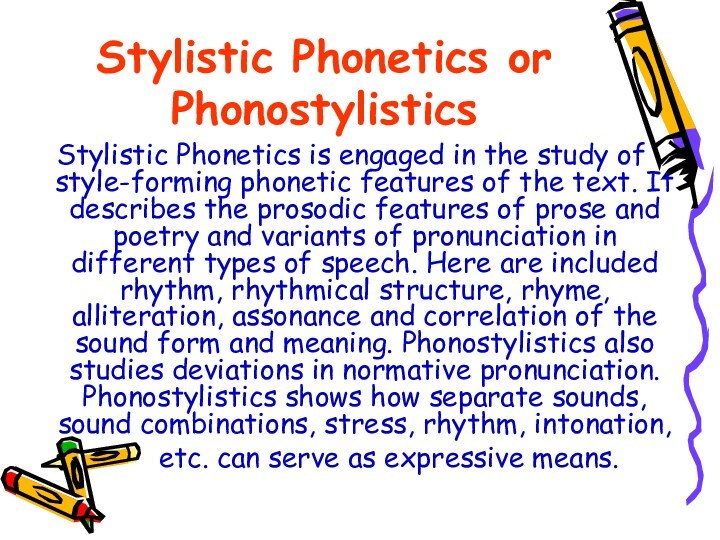
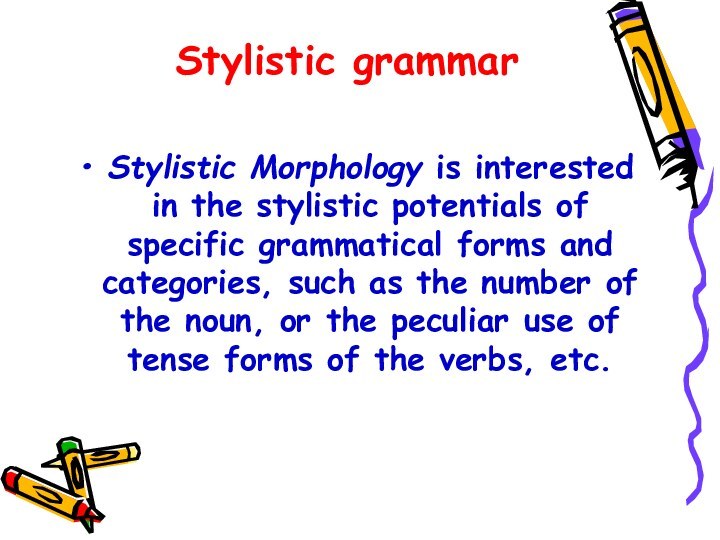
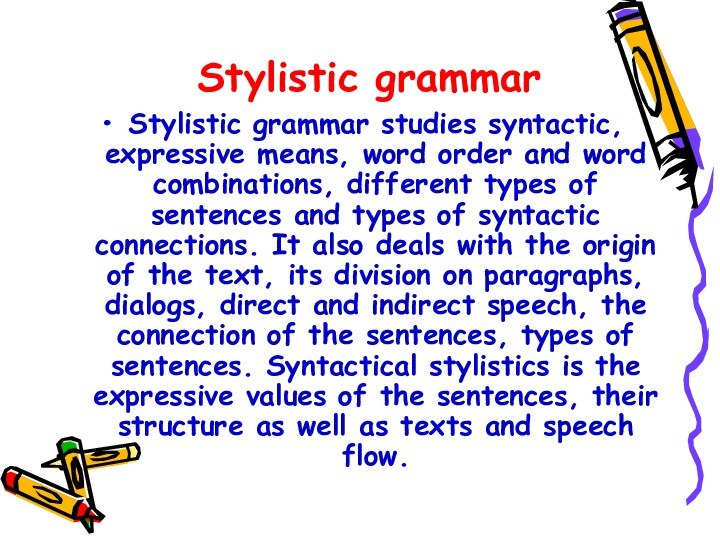
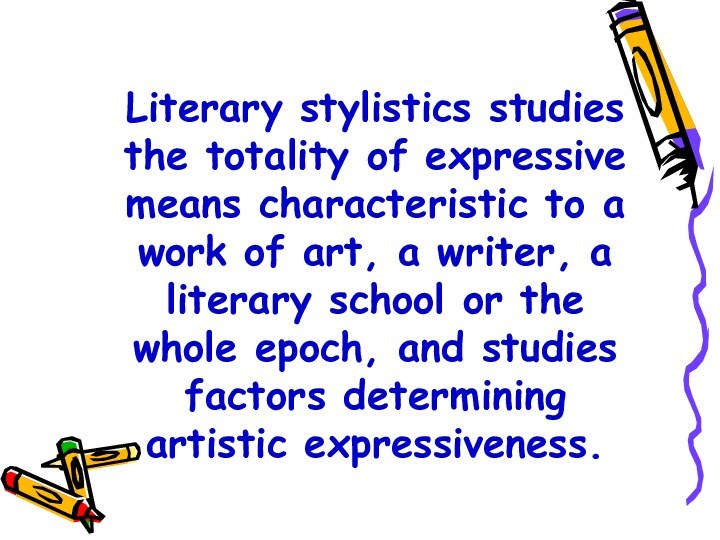

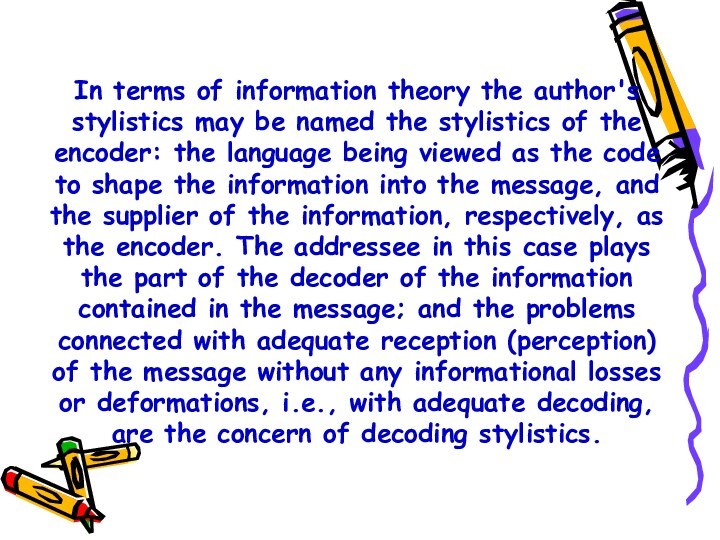

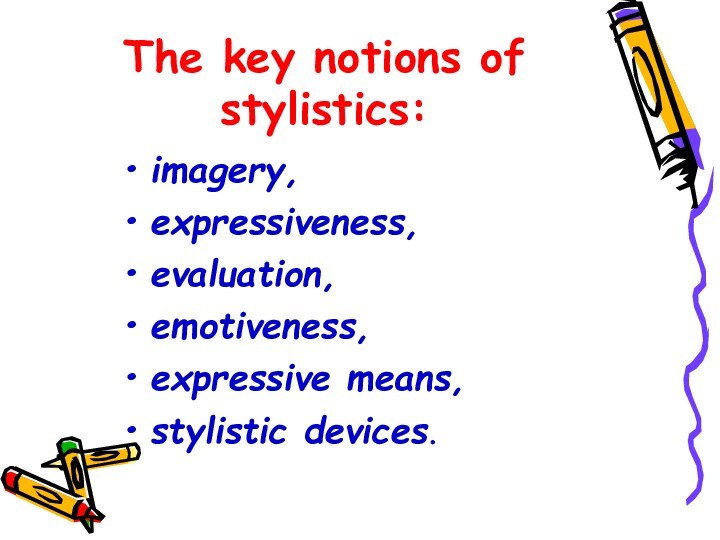
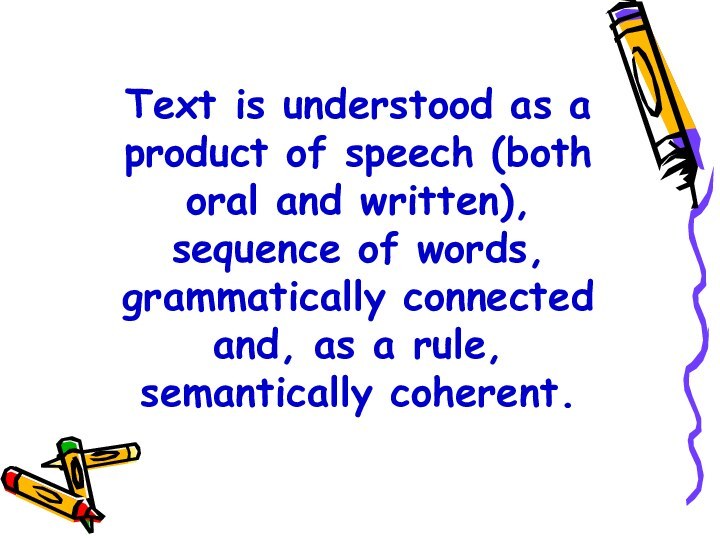
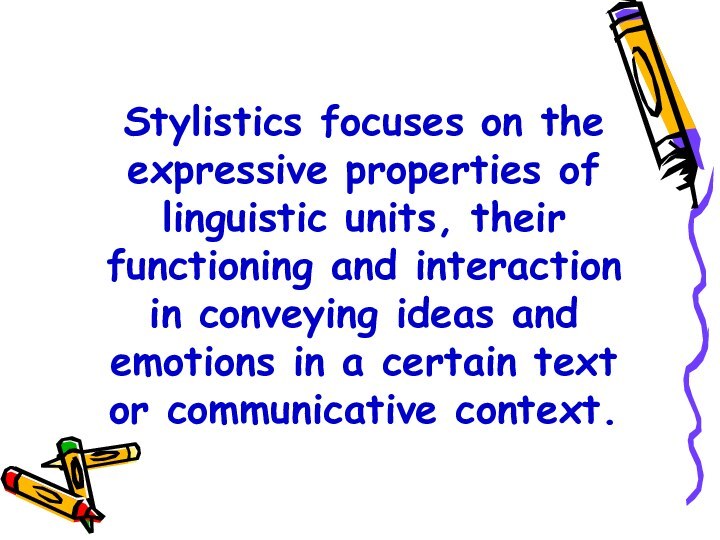
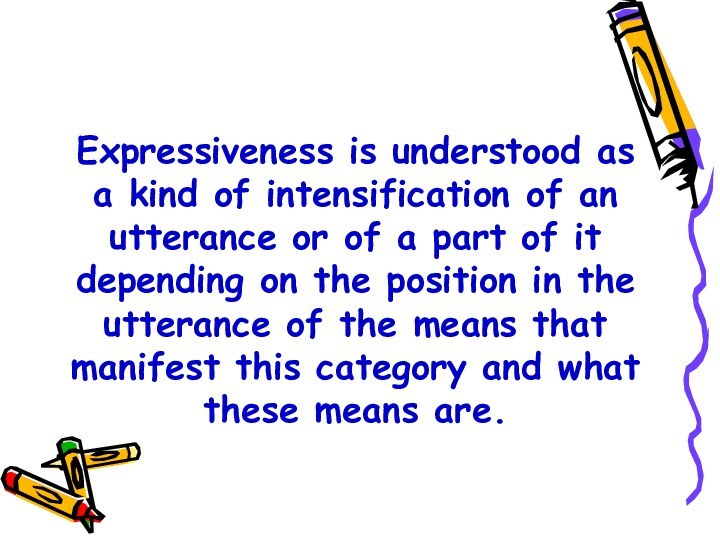


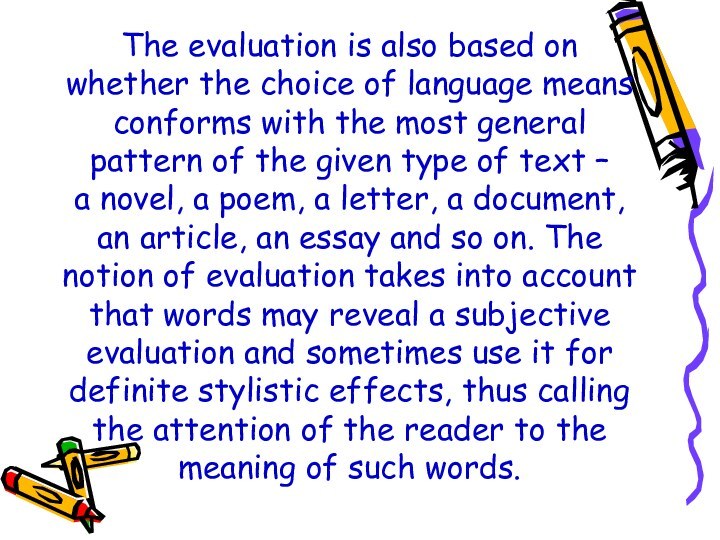
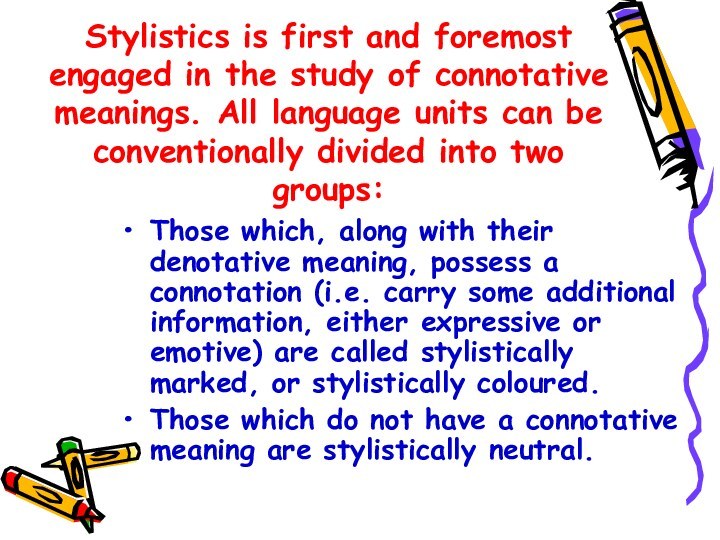
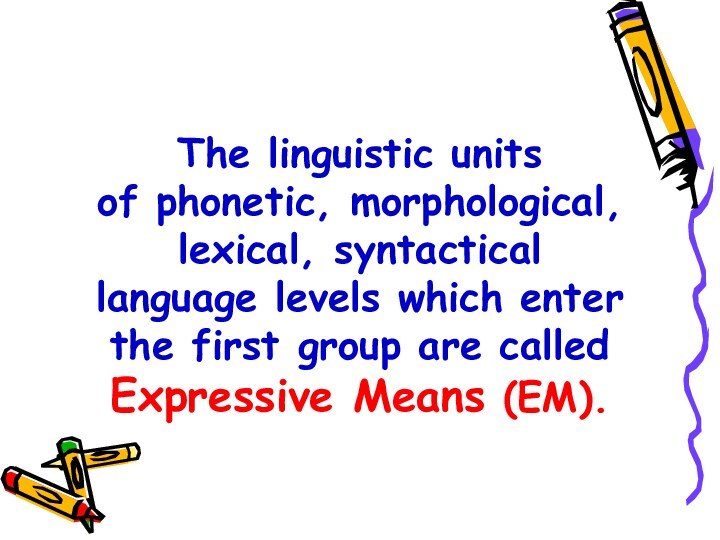

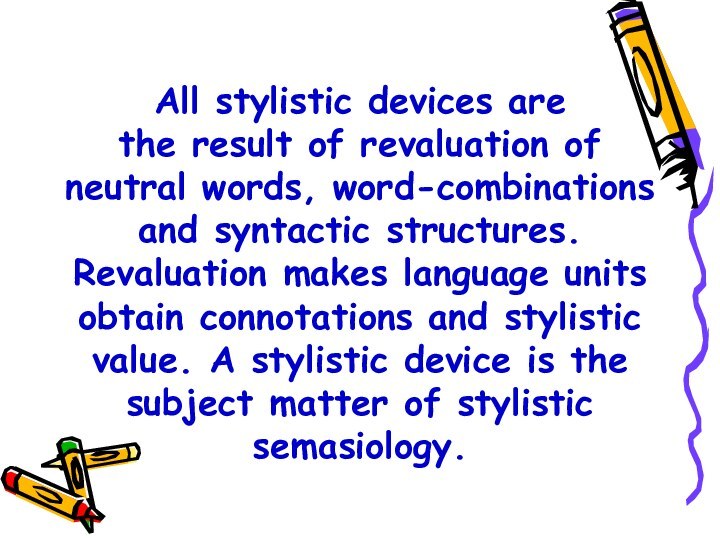

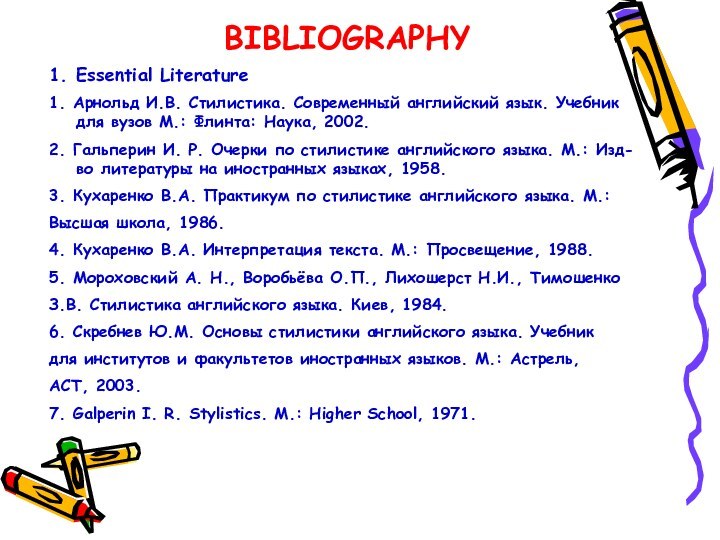
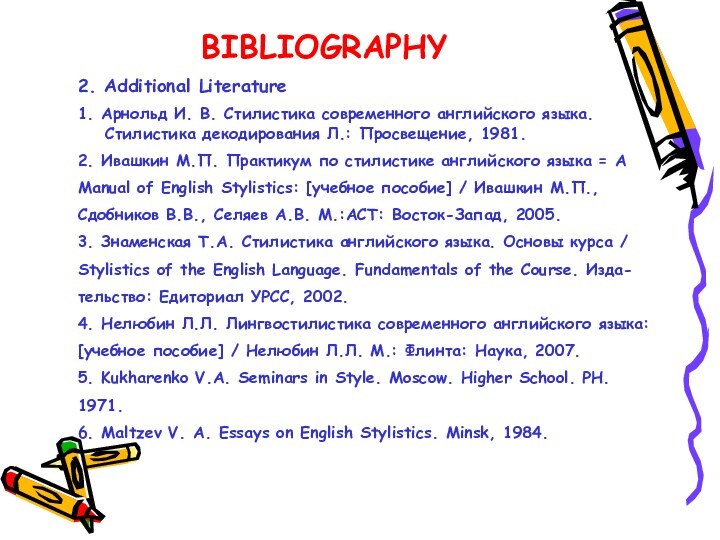
Слайд 3
Galperin:
“Style is a system of interrelated language
means which serves a definite aim in communication.”
Слайд 4
Y. M. Skrebnev:
“Style is a specificity of
sublanguage. Style can be roughly defined as the peculiarity,
the set of specific features of a text type or a concrete text. Style is just what differentiates a group of homogeneous texts (an individual text) from all other groups (other texts)."
Слайд 5
Seymour Chatman:
"Style is a product of individual choices
and patterns of choices among linguistic possibilities."
Слайд 6 The term “style” applies to the following fields
of investigation:
the interrelation between language and thought;
the aesthetic function
of language;expressive means in language;
emotional colouring of language;
a system of special devices called stylistic devices;
the splitting of the literary language into separate subsystems (genres, registers, discourses, functional styles etc.);
synonymous ways of rendering one and the same idea;
the individual manner of a writer or a speaker in making use of language to achieve the desirable effect in speech or in writing.
Слайд 8 The linguistic form of the idea expressed always
reflects the peculiarities of the thought. And vice versa,
the character of the thought will always in a greater or lesser degree manifest itself in the language forms chosen for the expression of the idea.
Слайд 10
Style is a technique
of expression.
In this
sense style is generally defined as the ability to
write clearly, correctly and in a manner calculated to the interest of the reader.Слайд 12 A style of language is a system of
interrelated language means which serves a definite aim in
communication.
Слайд 13
I. Arnold mentions four styles:
poetic style,
scientific
style,
newspaper style,
colloquial style.
Слайд 14 I.R. Galperin distinguishes five major functional styles in
the English literary standard:
the language of belles-letres.
the language of
publicistic literature.the language of newspapers.
the language of scientific prose.
the language of official documents.
Слайд 15
We distinguish six styles within the English language:
the
belles- letters style;
the publicist style;
the newspaper style;
the scientific prose
style;the style of official documents
the colloquial style.
Слайд 16
1.2. Style Study and its Subdivisions
Style Study is
a branch of general linguistics which investigates the principles
and the effect of the choice and usage of various language means (lexical, grammatical, phonetic) to convey thoughts and emotions in different communication conditions.Слайд 17 I. Galperin defines Style Study as a branch
of general linguistics, which deals with the following two
interdependent tasks:a) it studies the totality of special linguistic means (stylistic devices and expressive means) which secure the desirable effect of the utterance;
b) it studies certain types of texts "discourse" which due to the choice and arrangement of the language are distinguished by the pragmatic aspect of communication (functional styles).
Слайд 18 The subject matter of Style Study is emotional
expression of the language, the totality of the expressive
means.
Слайд 19
The main aims of Stylistics are:
1) to analyze
the choice of a definite language means in a
row of synonymous forms expressing the thought to convey the information most fully and effectively;2) to analyze different expressive means in the language hierarchy;
3) to define the stylistic function performed by any linguistic means.
Слайд 20 The stylistics of language analyses permanent or inherent
stylistic properties of language elements while the stylistics of
speech studies stylistic properties, which appear in a context, and they are called adherent. So, stylistics of language describes and classifies the inherent stylistic colouring of language units.
Слайд 21
Т.A. Znamenskaya:
Stylistics of speech studies the composition
of the utterance – the arrangement, selection and distribution
of different words, and their adherent qualities.Слайд 22 Stylistics of resources is a descriptive stylistics. It
studies stylistically coloured language means, expressive abilities and semantic
nuances of words, forms and constructions.Слайд 23 Comparative stylistics analyses the stylistic resources not inherent
in a separate language but at the crossroads of
two languages, or two literatures and is obviously linked to the theory of translation.Слайд 24 Linguo-stylistics compares National Language Standard or Norm with
particular, typical to different spheres of communication subsystems (called
functional styles) and dialects and studies language means with relation to their ability to express and evoke different feelings, additional associations and evaluation.Слайд 25 Language means may be studied at different levels:
vocabulary, grammar and phonetics, thus distinguishing lexical, grammatical and
phonetic stylistics.
Слайд 26
Stylistic lexicology or Lexical stylistics
Lexical stylistics studies
functions of direct and figurative meanings, also the way
the contextual meaning of a word is realized in the text. Lexical stylistics deals with various types of connotations – expressive, evaluative, emotive, ideological, pragmatic, stylistic; neologisms, dialectal words and their behavior in the text. Lexical stylistics studies the principles of the usage of words and word combinations performing their expressive functions. So, it studies the semantic structure of the word and the interrelation of the denotative and connotative meanings of a word, as well as the interrelation of the stylistic connotations of a word and the context.
Слайд 27
Stylistic Phonetics or Phonostylistics
Stylistic Phonetics is engaged in
the study of style-forming phonetic features of the text.
It describes the prosodic features of prose and poetry and variants of pronunciation in different types of speech. Here are included rhythm, rhythmical structure, rhyme, alliteration, assonance and correlation of the sound form and meaning. Phonostylistics also studies deviations in normative pronunciation. Phonostylistics shows how separate sounds, sound combinations, stress, rhythm, intonation,etc. can serve as expressive means.
Слайд 28
Stylistic grammar
Stylistic Morphology is interested in the
stylistic potentials of specific grammatical forms and categories, such
as the number of the noun, or the peculiar use of tense forms of the verbs, etc.
Слайд 29
Stylistic grammar
Stylistic grammar studies syntactic, expressive means, word
order and word combinations, different types of sentences and
types of syntactic connections. It also deals with the origin of the text, its division on paragraphs, dialogs, direct and indirect speech, the connection of the sentences, types of sentences. Syntactical stylistics is the expressive values of the sentences, their structure as well as texts and speech flow.Слайд 30 Literary stylistics studies the totality of expressive means
characteristic to a work of art, a writer, a
literary school or the whole epoch, and studies factors determining artistic expressiveness.Слайд 31 Functional stylistics deals with all the subdivisions of
the language and all their possible usages, is the
most all-embracing, "global" trend.Слайд 32 In terms of information theory the author's stylistics
may be named the stylistics of the encoder: the
language being viewed as the code to shape the information into the message, and the supplier of the information, respectively, as the encoder. The addressee in this case plays the part of the decoder of the information contained in the message; and the problems connected with adequate reception (perception) of the message without any informational losses or deformations, i.e., with adequate decoding, are the concern of decoding stylistics.Слайд 33 The stylistics, proceeding from the norms of language
usage at a given period and teaching these norms
to language speakers, especially the ones, dealing with the language professionally (editors, publishers, writers, journalists, teachers, etc.) is called practical stylistics.
Слайд 34
The key notions of stylistics:
imagery,
expressiveness,
evaluation,
emotiveness,
expressive means,
stylistic devices.
Слайд 35 Text is understood as a product of speech
(both oral and written), sequence of words, grammatically connected
and, as a rule, semantically coherent.Слайд 36 Stylistics focuses on the expressive properties of linguistic
units, their functioning and interaction in conveying ideas and
emotions in a certain text or communicative context.Слайд 37 Expressiveness is understood as a kind of intensification
of an utterance or of a part of it
depending on the position in the utterance of the means that manifest this category and what these means are.Слайд 38 Emotiveness, and correspondingly the emotive elements of language,
is what reveals the emotions of a writer or
a speaker. They are designed to awaken co-experience in the mind of the reader.Слайд 39 Expressiveness is a broader notion than emotiveness and
is by no means to be reduced to the
latter. Emotiveness is an integral part of expressiveness and occupies a predominant position in the category of expressiveness.Слайд 40 The evaluation is also based on whether the
choice of language means conforms with the most general
pattern of the given type of text – a novel, a poem, a letter, a document, an article, an essay and so on. The notion of evaluation takes into account that words may reveal a subjective evaluation and sometimes use it for definite stylistic effects, thus calling the attention of the reader to the meaning of such words.Слайд 41 Stylistics is first and foremost engaged in the
study of connotative meanings. All language units can be
conventionally divided into two groups:Those which, along with their denotative meaning, possess a connotation (i.e. carry some additional information, either expressive or emotive) are called stylistically marked, or stylistically coloured.
Those which do not have a connotative meaning are stylistically neutral.
Слайд 42 The linguistic units of phonetic, morphological, lexical, syntactical
language levels which enter the first group are called
Expressive Means (EM).Слайд 43 Stylistic devices (tropes, figures of speech) unlike expressive
means are not language phenomena. They are formed in
speech and most of them do not exist out of context. According to principles of their formation, stylistic devices are grouped into phonetic, lexico-semantic and syntactic types.Слайд 44 All stylistic devices are the result of revaluation
of neutral words, word-combinations and syntactic structures. Revaluation makes
language units obtain connotations and stylistic value. A stylistic device is the subject matter of stylistic semasiology.
Слайд 46
BIBLIOGRAPHY
1. Essential Literature
1. Арнольд И.В. Стилистика. Современный английский
язык. Учебник для вузов M.: Флинта: Наука, 2002.
2. Гальперин
И. Р. Очерки по стилистике английского языка. М.: Изд-во литературы на иностранных языках, 1958.3. Кухаренко В.А. Практикум по стилистике английского языка. М.:
Высшая школа, 1986.
4. Кухаренко В.А. Интерпретация текста. М.: Просвещение, 1988.
5. Мороховский А. Н., Воробьёва О.П., Лихошерст Н.И., Тимошенко
З.В. Стилистика английского языка. Киев, 1984.
6. Скребнев Ю.М. Основы стилистики английского языка. Учебник
для институтов и факультетов иностранных языков. М.: Астрель,
АСТ, 2003.
7. Galperin I. R. Stylistics. M.: Higher School, 1971.








